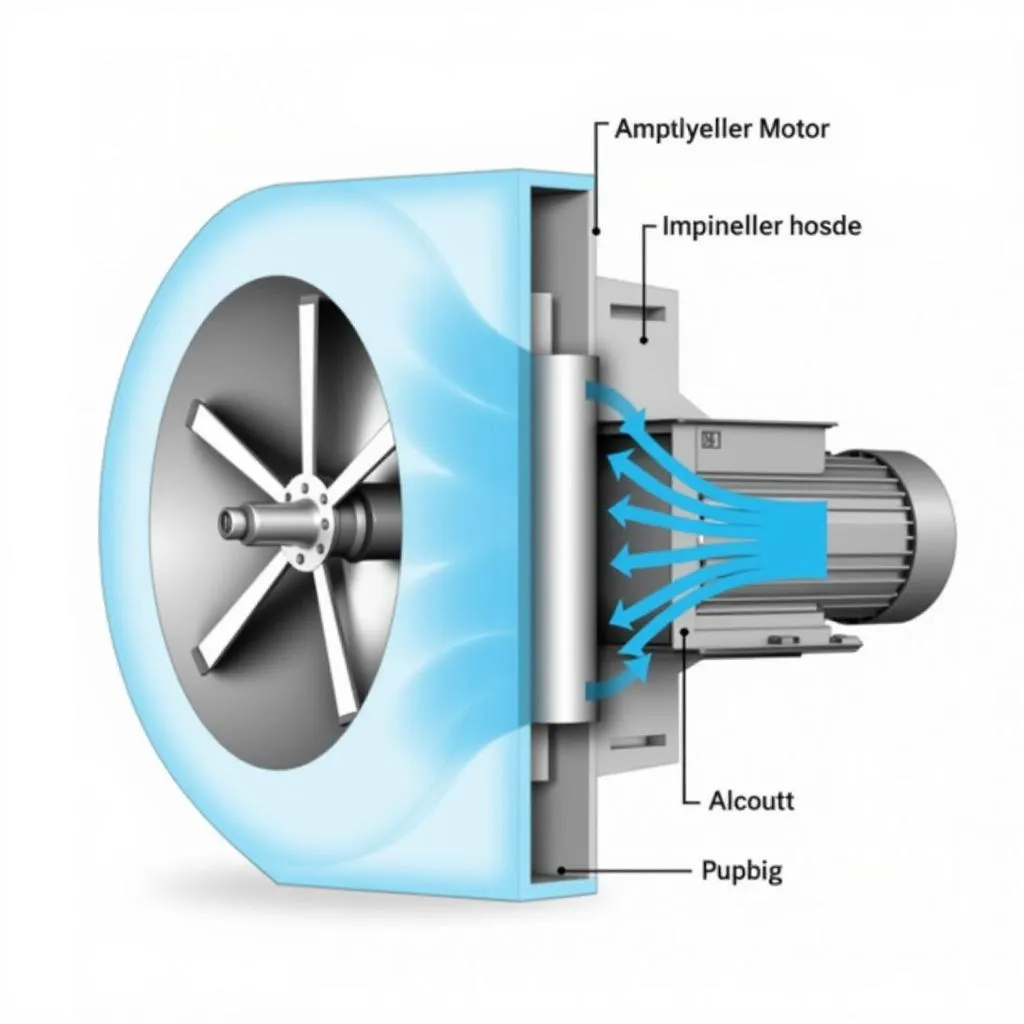Axial fans are a vital component in many industrial and residential applications. Their efficient design and operation play a crucial role in various systems, from cooling computers to ventilating large buildings. In this comprehensive guide, we will delve into the intricacies of Axial Fan Design, exploring its principles, key components, and optimization strategies.
Understanding Axial Fan Design
Axial fans, as their name suggests, generate airflow along their axis of rotation. This design distinguishes them from centrifugal fans, which create airflow perpendicular to the axis of rotation. The core principle behind axial fans lies in the conversion of rotational energy into kinetic energy of the airflow.
Key Components of an Axial Fan:
- Impeller: The heart of the axial fan, the impeller is a rotating set of blades that propel the air. The design and shape of the impeller blades significantly impact the fan’s performance.
- Hub: The central portion of the impeller that connects to the motor shaft.
- Motor: Provides the rotational power to drive the impeller.
- Housing: Encloses the fan components and directs airflow. The housing design can significantly influence the fan’s efficiency and noise level.
- Inlet and Outlet: These openings allow air to enter and exit the fan. The size and shape of these openings can influence airflow patterns and fan performance.
Principles of Axial Fan Operation
Axial fans work based on the principle of aerodynamics. As the impeller blades rotate, they create a pressure differential between the inlet and outlet of the fan. This pressure difference drives the airflow through the fan.
Factors Influencing Axial Fan Performance:
- Blade Angle: The angle of the blades relative to the rotational axis directly impacts the air velocity and pressure generated.
- Blade Number: A higher blade count generally leads to greater air volume but may also increase noise.
- Impeller Diameter: Larger diameter impellers typically generate higher airflow rates.
- Speed: The fan’s rotational speed significantly influences airflow rate and pressure.
Optimizing Axial Fan Design for Efficiency
Efficient axial fan design is crucial for minimizing energy consumption and maximizing performance. Here are some strategies:
- Aerodynamic Optimization: Simulations and wind tunnel testing can optimize blade shape and housing design to reduce drag and improve airflow.
- Material Selection: Lighter and stronger materials, like composites, can improve efficiency and reduce noise.
- Motor Efficiency: Choosing high-efficiency motors can significantly reduce energy consumption.
- Blade Tip Clearance: Reducing the gap between the blade tips and the housing minimizes energy loss and improves efficiency.
- Flow Straightening: Using flow straightening devices, like guide vanes, can improve airflow uniformity and efficiency.
Axial Fan Design: Considerations for Specific Applications
The optimal axial fan design for a specific application depends on various factors, including:
- Airflow Requirements: The volume of air to be moved determines the fan’s size and power.
- Pressure Requirements: The required pressure to overcome resistance in the system influences fan design.
- Noise Level: Noise limitations may necessitate design choices that minimize noise.
- Operating Environment: Factors like temperature, humidity, and dust levels can affect fan performance and lifetime.
Axial Fan Design: Common Applications
Axial fans are widely used in various industries and applications:
- HVAC Systems: Ventilation, air conditioning, and heating systems rely heavily on axial fans for efficient air circulation.
- Computer Cooling: Axial fans are essential for cooling CPUs, GPUs, and other electronic components.
- Industrial Applications: Ventilation, drying, and material handling systems often utilize axial fans.
- Automotive Systems: Cooling engines, HVAC systems, and other components.
- Consumer Products: Household appliances, such as fans, hair dryers, and vacuum cleaners.
Frequently Asked Questions (FAQ)
- Q: What is the difference between an axial fan and a centrifugal fan?
- A: Axial fans move air parallel to the axis of rotation, while centrifugal fans move air perpendicular to the axis of rotation. Axial fans are typically better for high-volume, low-pressure applications, while centrifugal fans are suited for high-pressure, lower-volume applications.
- Q: How do I choose the right axial fan for my application?
- A: Consider the required airflow rate, pressure, noise limitations, and operating environment. Consult with a qualified engineer or fan manufacturer for assistance.
- Q: What are some of the challenges associated with axial fan design?
- A: Challenges include achieving high efficiency, minimizing noise levels, optimizing blade design, and ensuring reliable operation in demanding environments.
- Q: How can I improve the efficiency of an existing axial fan?
- A: Consider blade cleaning, motor maintenance, reducing tip clearance, and using flow straightening devices.
- Q: What are the latest advancements in axial fan design?
- A: Advancements include the use of advanced materials, improved aerodynamic optimization, and noise reduction technologies.
 Axial fan design schematic
Axial fan design schematic
“The advancement in axial fan design is truly fascinating. It’s remarkable how engineers continue to refine the technology to enhance efficiency, reduce noise, and improve reliability,” – Dr. Emily Carter, Professor of Mechanical Engineering at Stanford University.
Conclusion
Understanding the intricacies of axial fan design is crucial for various industries. By optimizing design parameters, we can create fans that are highly efficient, quiet, and reliable. As technology advances, we can expect further innovations in axial fan design that will enhance their performance and broaden their applications.


